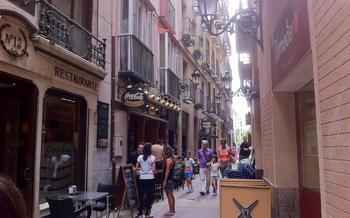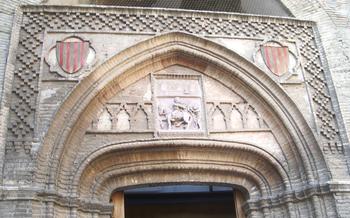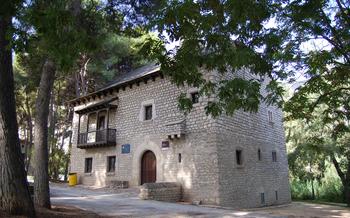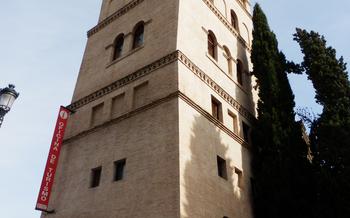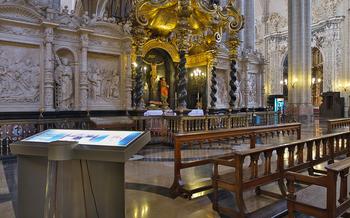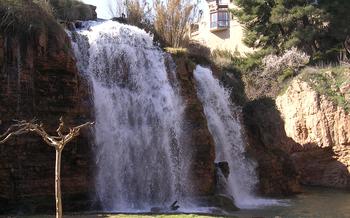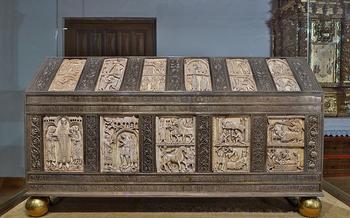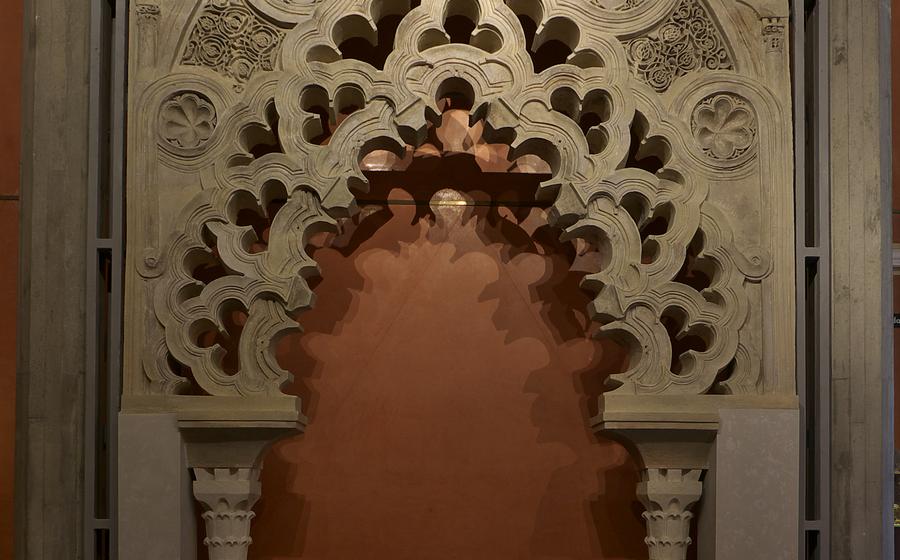
Palacio de la Aljafería
- The Palacio de la Aljafería: A Masterpiece of Islamic Architecture palace. The palace showcases a blend of Islamic and Christian architectural styles, reflecting Zaragoza's diverse history. Its intricate carvings, beautiful courtyards, and serene gardens captivate visitors, making it a must-visit destination for anyone exploring the city. In 1986, UNESCO recognized the Palacio de la Aljafería's exceptional value by designating it as a World Heritage Site. This prestigious recognition underscores the palace's significance as a masterpiece of Islamic architecture and a symbol of Zaragoza's vibrant cultural legacy.
- Exploring the Palace Grounds: A Journey Through Time
- The Mudéjar Transformation: A Blend of Cultures
- Throne Room: A Seat of Power and Splendor
- Hall of Kings: A Gallery of Majestic Portraits
- Chapel of San Martín: A Sacred Space
- Gardens of the Aljafería: A Haven of Tranquility
- Guided Tours: Unveiling the Palace's Secrets
- Accessibility and Facilities for Visitors
- Photography and Videography Guidelines
- Insider Tip: Hidden Treasures and Secret Spots
The Palacio de la Aljafería: A Masterpiece of Islamic Architecture palace. The palace showcases a blend of Islamic and Christian architectural styles, reflecting Zaragoza's diverse history. Its intricate carvings, beautiful courtyards, and serene gardens captivate visitors, making it a must-visit destination for anyone exploring the city. In 1986, UNESCO recognized the Palacio de la Aljafería's exceptional value by designating it as a World Heritage Site. This prestigious recognition underscores the palace's significance as a masterpiece of Islamic architecture and a symbol of Zaragoza's vibrant cultural legacy.
Exploring the Palace Grounds: A Journey Through Time
As you step through the grand entrance of the Palacio de la Aljafería, you are greeted by a breathtaking sight. The stunning exterior, with its intricate carvings and elegant arches, offers a glimpse into the architectural wonders that await within.
The palace grounds are a testament to the harmonious fusion of Islamic and Christian influences. Serene courtyards, adorned with colorful tiles and fragrant flowers, create a tranquil oasis amidst the bustling city. Tranquil gardens, with their lush greenery, shady trees, and soothing water features, invite you to pause and contemplate the beauty of your surroundings.
Intricate carvings and decorative motifs adorn every corner of the palace, showcasing the exceptional craftsmanship of its builders. Geometric patterns, vegetal motifs, and Qur'anic inscriptions intertwine, creating a visual symphony that captivates the viewer.
As you wander through the palace grounds, you can almost feel the presence of those who once resided here. The echoes of laughter, whispered secrets, and the cadence of everyday life seem to linger in the air, transporting you back in time to the days when the palace was a vibrant hub of activity.
The Mudéjar Transformation: A Blend of Cultures
After the reconquest Aljafería underwent a significant transformation, blending Islamic and Christian elements to create a unique architectural style known as Mudéjar. This style emerged as a result of the coexistence of different cultures and religions in the region, with Islamic artisans and craftsmen continuing to work under Christian rule.
The Mudéjar influence can be seen in various parts of the palace, including intricate plasterwork, ceramic tiles, and decorative arches. The fusion of Islamic and Christian elements created a harmonious and visually stunning style that became a defining feature of Aragonese architecture.
The Mudéjar transformation of the Palacio de la Aljafería stands as a testament to the rich cultural exchange and collaboration that took place in medieval Spain. This unique architectural style reflects the region's complex history and the ability of different cultures to coexist and create something truly remarkable.
Throne Room: A Seat of Power and Splendor
The throne room of the Palacio de la Aljafería is a testament to the grandeur and power of the rulers who once resided within its walls. It is a spacious and awe-inspiring chamber, adorned with intricate stucco carvings and geometric designs that create a mesmerizing visual spectacle. Elaborate arches and domed ceilings soar overhead, adding to the sense of majesty and opulence.
The centerpiece of the throne room is the opulent throne itself, an elaborate seat of power and authority. It is intricately carved with intricate patterns and adorned with precious stones and metals, reflecting the wealth and prestige of the rulers who sat upon it.
The walls of the throne room are adorned with vibrant tiles, each hand-painted with intricate designs and patterns. These tiles depict scenes from history, mythology, and religion, offering a glimpse into the rich cultural heritage of the palace's inhabitants.
The throne room is more than just a symbol of power and authority; it is also a testament to the artistic and architectural prowess of the artisans and craftsmen who created it. It is a masterpiece of Islamic architecture, blending elements from both the East and the West to create a unique and awe-inspiring space.
Hall of Kings: A Gallery of Majestic Portraits
Among the many treasures of the Palacio de la Aljafería, the Hall of Kings stands out as a captivating gallery of regal portraits. This majestic hall is adorned with an impressive collection of paintings depicting Aragonese monarchs and other notable figures from the kingdom's history.
The portraits, executed in various artistic styles and techniques, offer a glimpse into the lineage and history of Aragon. Each painting captures the essence of its subject, showcasing their regal attire, distinctive features, and expressions that hint at their personalities and accomplishments.
Visitors can admire the likenesses of powerful rulers like Alfonso I the Battler, known for his military prowess and conquests, and Peter III the Great, who expanded the kingdom's territories and established Aragon as a major power in the Mediterranean.
The Hall of Kings serves as a testament to the rich history and heritage of Aragon, paying homage to the monarchs who shaped its destiny and left an indelible mark on the region's culture and identity.
Chapel of San Martín: A Sacred Space
The Palacio de la Alja place of worship.
The Chapel of San Martín is a beautiful example of Gothic architecture, with its pointed arches, ribbed vaults, and intricate stained-glass windows. The chapel is adorned with Christian symbolism, including a large altarpiece depicting scenes from the life of Saint Martin of Tours.
The Chapel of San Martín is a peaceful and serene space, offering a moment of tranquility amidst the grandeur of the palace. It is a reminder of Zaragoza's rich religious diversity and the peaceful coexistence of different faiths throughout its history.
Gardens of the Aljafería: A Haven of Tranquility
find respite and tranquility in its enchanting gardens. These beautifully landscaped grounds offer a serene oasis, inviting visitors to stroll along peaceful walkways, relax in secluded corners, and admire the vibrant colors and fragrant aromas of nature.
The gardens are a testament to the palace's rich history and cultural influences. They feature a harmonious blend of Islamic and Christian elements, reflecting the diverse heritage of Zaragoza. Visitors can marvel at aromatic plants, colorful flowers, and shady trees, creating a vibrant tapestry of colors and textures.
Fountains and water features add a touch of tranquility to the gardens, their gentle sounds creating a peaceful ambiance. Visitors can sit by the fountains, listen to the soothing water melodies, and let their worries melt away.
The gardens of the Palacio de la Aljafería are not just a place of beauty but also a place of historical significance. They were once used by the palace's residents for relaxation, contemplation, and entertainment. Today, they continue to serve as a place for visitors to find solace, inspiration, and a deeper connection to the palace's past.
Whether you seek a moment of peace, a romantic stroll, or simply a chance to admire the beauty of nature, the gardens of the Palacio de la Aljafería offer a tranquil haven that will leave you feeling refreshed and rejuvenated.
Guided Tours: Unveiling the Palace's Secrets
To fully grasp the rich history and intricate details of the Palacio de la Aljafería, guided tours are a must. Knowledgeable and passionate guides lead visitors through the palace's grand halls, courtyards, and gardens, sharing historical insights, anecdotes, and lesser-known stories that bring the palace's past to life.
These tours are available in various languages and cater to different interests and age groups. Standard tours provide a comprehensive overview of the palace's history, architecture, and significance. Specialized tours focus on specific aspects, such as the Islamic heritage, the Mudéjar style, or the legends and romances associated with the palace.
Visitors can pre-book guided tours online or at the palace's ticket office. Advance booking is recommended, especially during peak tourist season, to secure a spot and avoid waiting. Group discounts and rates are available for larger groups.
Whether you're a history buff, an architecture enthusiast, or simply curious about the stories that lie within the walls of the Palacio de la Aljafería, a guided tour is the key to unlocking its secrets and gaining a deeper appreciation for this architectural masterpiece.
Accessibility and Facilities for Visitors
Ensuring a welcoming and inclusive environment for all visitors, the Palacio de la Aljafería offers a range of accessibility features and facilities. Wheelchair users and visitors with limited mobility can easily navigate the palace grounds, with designated parking areas and accessible routes throughout the complex. Restrooms are conveniently located and adapted for wheelchair accessibility, providing a comfortable experience for all. Additionally, cafes and gift shops are available within the palace, offering refreshments and souvenirs for visitors to enjoy.
For those seeking more information, the palace provides comprehensive visitor guides and brochures, outlining ticket prices, discounts, and group rates. Advance booking is recommended, especially during peak tourist season, to secure your spot and avoid queues. Whether you're a history buff, an architecture enthusiast, or simply looking for a captivating cultural experience, the Palacio de la Aljafería caters to visitors of all interests and abilities, ensuring an enjoyable and memorable visit.
Photography and Videography Guidelines
The Palacio de la Aljafería welcomes photography and videography for personal and non-commercial use. However, to ensure the preservation of the palace and the privacy of other visitors, certain guidelines must be followed:
-
Designated Areas: Photography and videography are permitted in designated areas throughout the palace. These areas are marked with signs and include the courtyards, gardens, and main halls.
-
Restrictions: The use of flash, tripods, and professional equipment is prohibited inside the palace. This is to protect the delicate artwork and artifacts from damage.
-
Respect for Others: Visitors are kindly requested to be mindful of other visitors and avoid blocking walkways or disrupting ongoing events.
-
Commercial Use: Commercial photography and videography require prior authorization from the palace administration. Please contact the palace office for more information and to obtain the necessary permits.
By adhering to these guidelines, visitors can help preserve the beauty and integrity of the Palacio de la Aljafería while capturing their own memories of this magnificent landmark.
Insider Tip: Hidden Treasures and Secret Spots
Beyond the main attractions, the Palacio de la Aljafería holds hidden treasures and secret spots that offer a unique and intimate experience for visitors. One such hidden gem is a secluded courtyard tucked away from the main tourist routes. This tranquil oasis boasts stunning panoramic views of Zaragoza, making it the perfect spot to escape the crowds and soak in the beauty of the city.
Another secret passageway, known only to a few, leads to a forgotten chamber that has remained untouched for centuries. This hidden room, with its ancient inscriptions and faded frescoes, offers a glimpse into the palace's rich history and the lives of its former occupants.
To fully appreciate the palace's grandeur and avoid the crowds, consider visiting during the off-season or on weekdays when there are fewer visitors. This will allow you to explore the palace at your own pace, capture stunning photos without distractions, and engage in meaningful conversations with the knowledgeable guides.
Remember to take advantage of the photography guidelines and designated areas to capture the perfect shots of the palace's intricate details and serene gardens. By following these guidelines, you can not only preserve the palace's beauty for future generations but also share your unique perspective with others.
With these insider tips, you can unlock the hidden treasures of the Palacio de la Aljafería and create lasting memories of your visit to this architectural masterpiece.
